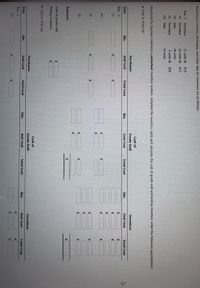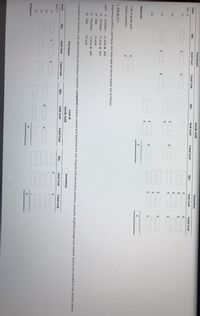
FINANCIAL ACCOUNTING
10th Edition
ISBN: 9781259964947
Author: Libby
Publisher: MCG
expand_more
expand_more
format_list_bulleted
Concept explainers
Topic Video
Question

Transcribed Image Text:The image displays an inventory management exercise involving hammers, which includes data on beginning inventory, purchases, and sales. The following is a transcription and explanation suitable for an educational website:
---
**Inventory Management for Hammers:**
**Beginning Inventory, Purchases, and Sales Data:**
- **March 3**:
- Beginning Inventory: 12 units at $15 each
- **Transactions:**
- March 11: Purchase of 13 units at $17 each
- March 19: Purchase of 9 units at $19 each
- March 25: Purchase of 21 units at $20 each
- March 29: Sale of 10 units
**Objective:**
Calculate the cost of goods sold and ending inventory using a perpetual inventory system under the following cost-flow assumptions:
1. **First-in, First-out (FIFO)**
2. **Last-in, First-out (LIFO)**
**Inventory Record Structure:**
The inventory records are structured with columns for:
- Date
- Quantity (Qty.)
- Unit Cost
- Total Cost
These are divided into sections for Purchases, Cost of Goods Sold, and Inventory Balances.
### Method Definitions:
- **FIFO (First-in, First-out):** Assumes the oldest inventory items are sold first.
- **LIFO (Last-in, First-out):** Assumes the newest inventory items are sold first.
The exercise requires completing inventory cards for each transaction date, detailing the flow of costs in and out of the system, and calculating the resulting balances in the inventory account.
### Diagram Explanation:
The diagram consists of a table with placeholders where calculations should be input for each transaction under both FIFO and LIFO assumptions. Each row represents a transaction or balance calculation.
- **Purchases:** The quantities and costs of items acquired during the period.
- **Cost of Goods Sold (COGS):** Reflects which items (and costs) have left inventory following sales.
- **Inventory Balances:** Displays remaining quantities and costs after each transaction.
This exercise is designed to help students understand practical applications of FIFO and LIFO in inventory management, emphasizing how these methods impact financial statements.
---
This explanation contextualizes the transcribed data for educational purposes, guiding learners through the inventory management process.

Transcribed Image Text:---
### Cost of Goods Sold and Ending Inventory Calculation
**EX7-8, EX7-9, EX7-10**
Beginning inventory, purchases, and sales data for tennis rackets are as follows:
- **April 3**
- Beginning Inventory: 12 units @ $45
- Sold: 21 Units
- **April 11 Purchases**
- 15 units @ $47
- Sold: 18 Units
- **April 21 Purchases**
- 10 units @ $50
- Sold: 10 Units
- **April 25 Sold**
- Remaining Units Sold: 14 Units
**Instructions:**
Complete the inventory cost card assuming the business maintains a perpetual inventory system and determine the cost of goods sold and ending inventory using the weighted average cost method. Round your answers to two decimal places.
#### Balances:
- **Beginning Inventory on April 3**
- Quantity: 25
- **Updates for April 3, 11, 21, 25**
- Calculate updates on quantities and costs for each transaction.
#### Purchases:
Fill out the table for each transaction, inputting the quantity, unit cost, and total cost for each purchase.
#### Cost of Goods Sold (COGS):
Complete the table to calculate the cost of goods sold, entering the quantity, unit cost, and total cost for each sale.
#### Inventory:
Maintain records of inventory, reflecting adjustments after each transaction.
**Note:** Follow the format of entering data in the given slots, ensuring all calculations for each date are accurately recorded. Ensure all monetary values are calculated to two decimal places for precision.
---
Expert Solution
This question has been solved!
Explore an expertly crafted, step-by-step solution for a thorough understanding of key concepts.
This is a popular solution
Trending nowThis is a popular solution!
Step by stepSolved in 3 steps with 6 images

Knowledge Booster
Learn more about
Need a deep-dive on the concept behind this application? Look no further. Learn more about this topic, accounting and related others by exploring similar questions and additional content below.Similar questions
- Inventory Write-Down The following information is taken from Aden Company's records: Product Group Units Cost/Unit Market/Unit A 1 600 $1.10 $0.90 B 1. 250 1.50 1.55 200 4.90 5.15 D. 100 6.50 6.40 3 80 25.00 24.60 Required: What is the correct inventory value if the company applies the LCNRV rule to each of the following? a. Individual items Product A 540 Product B 450 x Product C 980 Product D 640 Product E 1,968 V Total inventory value 4,578 x b. Groups of items Group 1 1,005 x Group 2 1,630 Group 3 1,968 Total inventory value 4,603 x c. The inventory as a whole Total inventory value 4,643 x %24 %24 %24 %24arrow_forwardThe following data represent the beginning inventory and, in order of occurrence, the purchases and sales of Per Beginning Inventory Sale No. 1 Purchase No. 1 Sale No. 2 Purchase No. 2 Totals Select one: O Units Unit Cost Total Cost Units Sold 50 $124 $6,200 A. $5,952 B. $4,320 C. $4,800 D. $4,224 30 40 120 100 88 3,000 40 32 Assuming Petroni, Inc. uses FIFO perpetual inventory procedures, the ending inventory cost is: 3,520 $12,720 72arrow_forwardQuestion #1 Unit cost/ Units Sales price Opening Inventory 2,000 3.70 Purchase #1 8,000 4.10 Sale #1 6,000 12.00 Purchase #2 5,000 4.30 Sale #2 3,000 12.00 Compute the following: a) Ending inventory (Perpetual) using FIFO. b) COGS (Perpetual) using moving weighted average. c) Ending inventory (Periodic) using weighted average.arrow_forward
- Paragraph 151 Styles Assume an outlet of The Runner's Store has the following data: Date Item Quantity Unit Costs Sale Price Aug 1 Beginning balance 40 $40 Sale 16 $70 8 Purchase 80 41 11 Sale 34 70 19 Sale 72 24 Sale 30 72 30 Purchase 18 42 Requirements: a) Calculate the Cost of Goods Sold and Ending Inventory using FIFO method. b) Calculate the Cost of Goods Sold and Ending Inventory using Weighted Average method. c) Calculate the gross profit under FIFO and Weighted Average method. d) Prepare the journal entries for August 3 and August 8 based on FIFO method. a) FIFO Opening and Purchases Cost of Goods Sold Balance Date Unit Unit Amount Unit Unit Amount Unit Unit Amount Cost Cost Cost Totalarrow_forwardpr.2arrow_forwardJayarrow_forward
- Income Statement Sales Revenue Cost of Goods Sold* Gross Profit Operating Expenses Income from Operations Income Tax Expense Net Income *Cost of Goods Sold Equation Beginning Inventory Purchases Goods Available for Sale Ending Inventory Cost of Goods Sold Units 3,000 3,000 $ $ 3,000 $ FIFO Inventory Costing Method LIFO 3,000 3,000 3,000 3,000 0 0 0 0 0 0 0 Weighted Average $ $ 0 0 0 0 0arrow_forwardThe following inventory information is gathered from the accounting records of Tucker Enterprises: # of Units x Unit Cost = Total Beginning Inventory 4000 x 5 Purchases 6000 x 7 Sales 9000 x 10 Ending Inventory 1000 a. Calculate Ending Inventory # of Units Unit Cost Ending Inventory 1.FIFO 0 $- 2.LIFO 0 $- 3.Weighted Average Cost 0 $- $- $- $- b. Cost of Goods Sold # of Units # of Units Unit cost Unit cost Cost of Goods Sold 1.FIFO $- 2.LIFO $- 3.Weighted Average Cost $- $- 0 $- c.Gross profit using each of the following methods: Sales Cost of Goods Sold Gross Profit 1.FIFO $- $- $- 2.LIFO $- $- $- 3.Weighted Average Cost $- $- $-arrow_forwardPlease do not give solution in image format thankuarrow_forward
- Please don't give image formatarrow_forwarda. Chapters 1-7 G Traducir antaFe iriclars Sotems TB MC Qu. 6-137 Using a perpetual inventory system, how... Using a perpetual Iventory system, how should a company record the sale of Inventory costing $550 for $1,170 on account? 1. InventorY 550 Cost oE GOods Sold 550 Sales Revenue 1,170 Accounts Receivable 1,170 2. Accounts Receivable 1,170 Sales Revenue 1,170 Cost of Goods Sold 550 Inventory 550 550 3. Inventory 620 Gain 1,170 Sales Revenue 1,170 Accounts Receivable 550 Sales Revenues 620 Gain Multiple Choice Nearrow_forwardDetermine the ending inventory amount by applying the lower of cost or market value to a. Each inventory item of inventoryb. Total inventory The following data refer to Froning Company’s ending inventoryItem Code, Quantity, Unit Cost, Unit MarketLXC 60 $45 $48KMT 210 $38 $34MOR 300 $22 $20NES 100 $27 $32arrow_forward
arrow_back_ios
arrow_forward_ios
Recommended textbooks for you

 AccountingAccountingISBN:9781337272094Author:WARREN, Carl S., Reeve, James M., Duchac, Jonathan E.Publisher:Cengage Learning,
AccountingAccountingISBN:9781337272094Author:WARREN, Carl S., Reeve, James M., Duchac, Jonathan E.Publisher:Cengage Learning, Accounting Information SystemsAccountingISBN:9781337619202Author:Hall, James A.Publisher:Cengage Learning,
Accounting Information SystemsAccountingISBN:9781337619202Author:Hall, James A.Publisher:Cengage Learning, Horngren's Cost Accounting: A Managerial Emphasis...AccountingISBN:9780134475585Author:Srikant M. Datar, Madhav V. RajanPublisher:PEARSON
Horngren's Cost Accounting: A Managerial Emphasis...AccountingISBN:9780134475585Author:Srikant M. Datar, Madhav V. RajanPublisher:PEARSON Intermediate AccountingAccountingISBN:9781259722660Author:J. David Spiceland, Mark W. Nelson, Wayne M ThomasPublisher:McGraw-Hill Education
Intermediate AccountingAccountingISBN:9781259722660Author:J. David Spiceland, Mark W. Nelson, Wayne M ThomasPublisher:McGraw-Hill Education Financial and Managerial AccountingAccountingISBN:9781259726705Author:John J Wild, Ken W. Shaw, Barbara Chiappetta Fundamental Accounting PrinciplesPublisher:McGraw-Hill Education
Financial and Managerial AccountingAccountingISBN:9781259726705Author:John J Wild, Ken W. Shaw, Barbara Chiappetta Fundamental Accounting PrinciplesPublisher:McGraw-Hill Education


Accounting
Accounting
ISBN:9781337272094
Author:WARREN, Carl S., Reeve, James M., Duchac, Jonathan E.
Publisher:Cengage Learning,

Accounting Information Systems
Accounting
ISBN:9781337619202
Author:Hall, James A.
Publisher:Cengage Learning,

Horngren's Cost Accounting: A Managerial Emphasis...
Accounting
ISBN:9780134475585
Author:Srikant M. Datar, Madhav V. Rajan
Publisher:PEARSON

Intermediate Accounting
Accounting
ISBN:9781259722660
Author:J. David Spiceland, Mark W. Nelson, Wayne M Thomas
Publisher:McGraw-Hill Education

Financial and Managerial Accounting
Accounting
ISBN:9781259726705
Author:John J Wild, Ken W. Shaw, Barbara Chiappetta Fundamental Accounting Principles
Publisher:McGraw-Hill Education